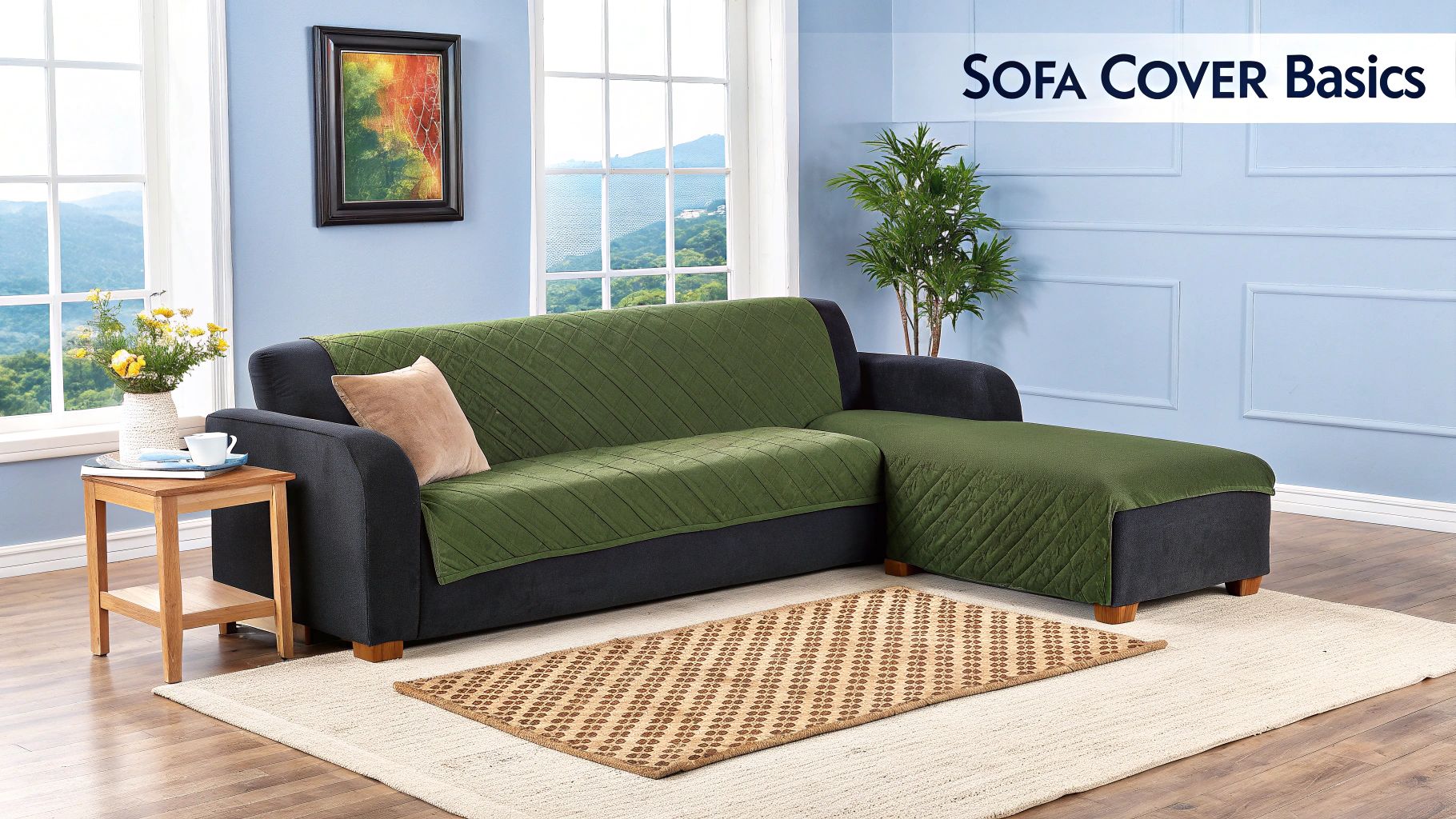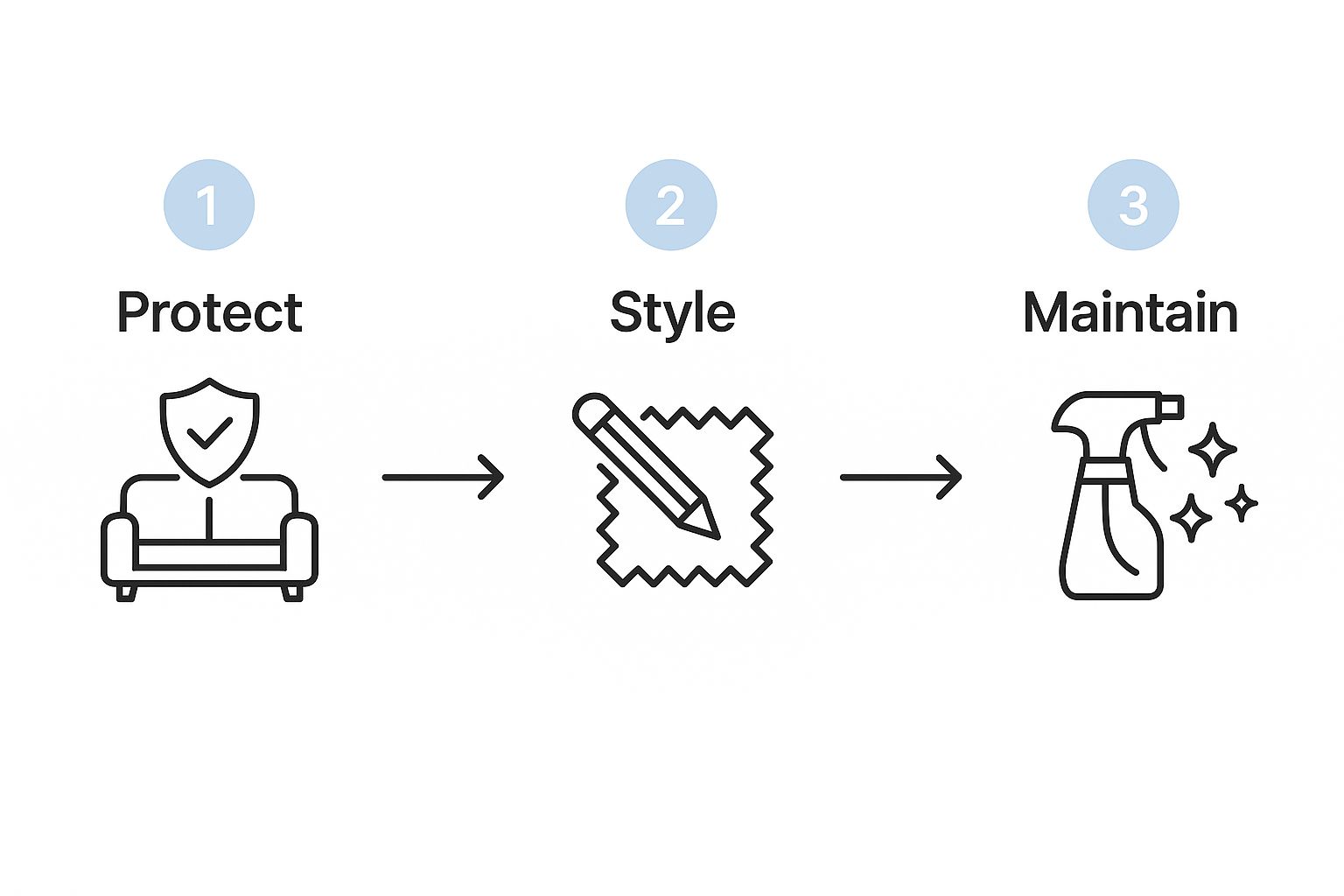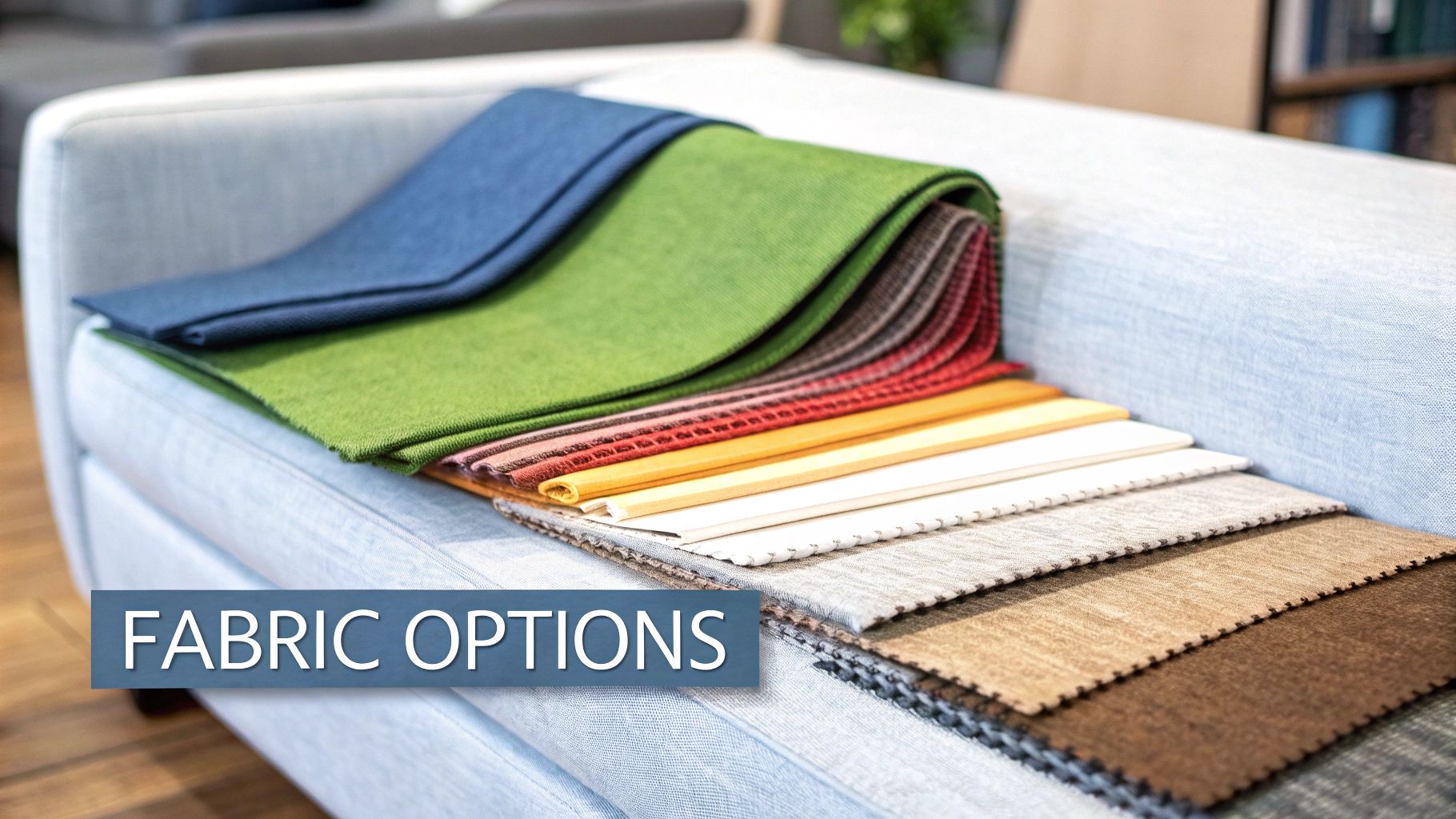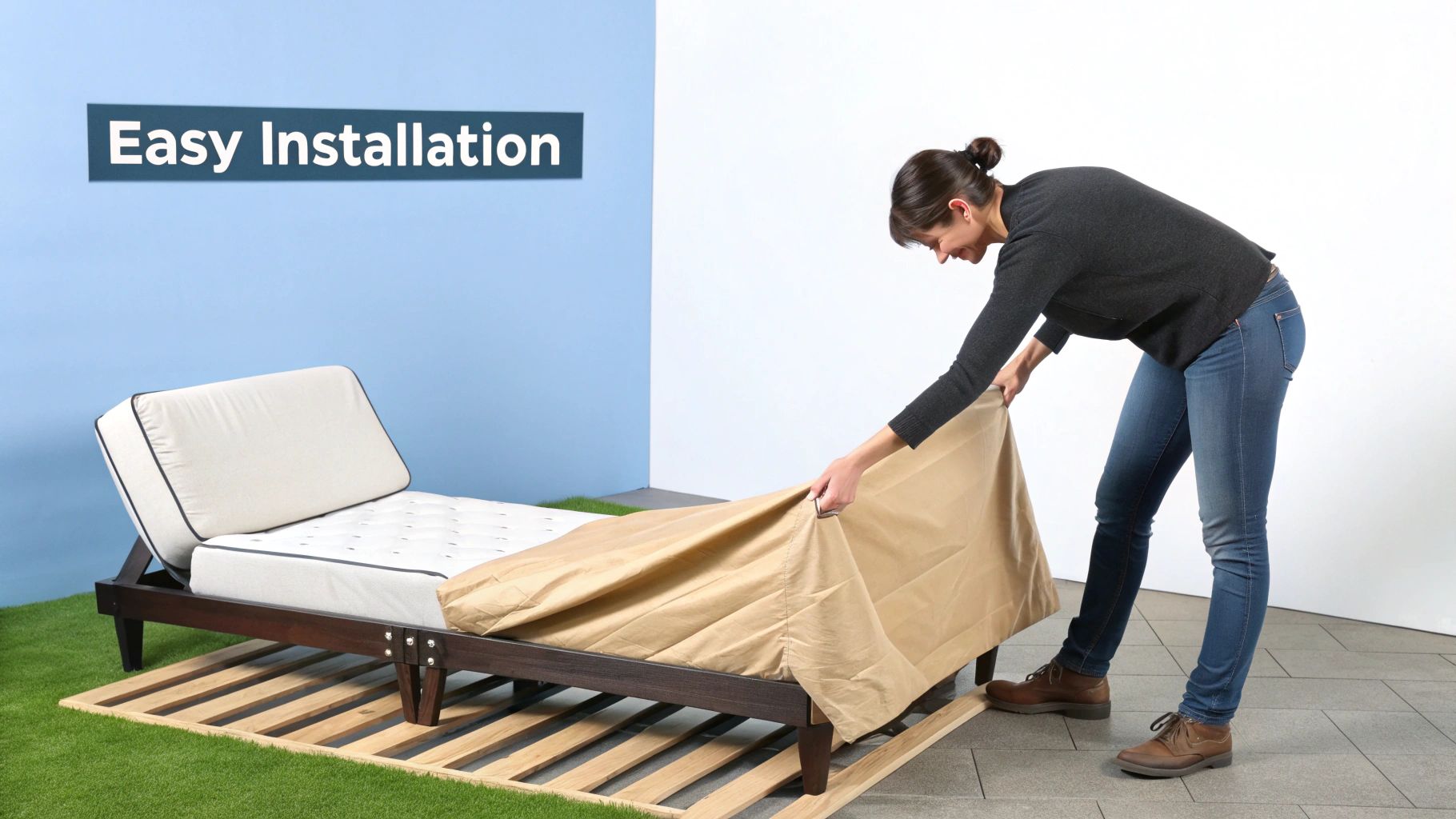A good chaise sofa cover is one of the best tricks in the book for protecting your furniture while giving your living space an instant facelift. It's hands down the easiest way to shield your sofa from spills, pet hair, and general wear and tear, serving as a stylish and budget-friendly alternative to buying a whole new lounge suite.
This guide will walk you through everything you need to know to find the perfect cover.
Give Your Sofa a Second Chance

Let's be honest, the chaise sofa is usually the most loved (and used) piece of furniture in the house. It's where you crash for movie nights, sneak in an afternoon nap, and catch up with family. But life is messy. All that daily use can leave it looking a bit tired, faded, or stained, making you wonder if it's time for a costly replacement.
Before you start shopping for a new sofa, consider a high-quality chaise sofa cover. It’s so much more than just a protective sheet; it’s a design choice that can completely redefine your room's aesthetic. Think of it as a fresh new outfit for your favourite piece of furniture.
Why a Sofa Cover Is a Smart Investment
Investing in a good cover is a brilliant move that solves a lot of common frustrations. It’s an immediate fix for cosmetic flaws and a smart way to prevent future damage before it happens.
Here’s why it’s such a practical choice:
- A Budget-Friendly Makeover: You get the look and feel of a brand-new sofa for just a fraction of the cost.
- Defence Against Daily Life: It acts as a barrier against everything from pet claws and kids' snacks to accidental spills and sunlight fading the original fabric.
- Hassle-Free Cleaning: Most modern covers are machine-washable, which is a lifesaver for busy households. Just zip it off and toss it in the wash.
- Endless Style Options: Fancy a change? You can swap out your cover to match seasonal decor, or just whenever you feel like a new colour scheme.
It's not just a niche product anymore, either. The global demand for sofa covers is booming. The market was valued at around USD 2.5 billion in 2024 and is set to grow even more, which shows a real shift towards furniture preservation and smarter, more sustainable home styling.
This surge in popularity means more innovation and better options for all of us. New fabric technologies and clever designs are making today's chaise sofa covers more durable, stylish, and user-friendly than ever. If you're curious about where the industry is heading, you can dive into the latest sofa cover market research to see the trends.
How to Measure for a Flawless Fit
Let's be honest, nothing kills the vibe of a new chaise sofa cover quicker than a bad fit. If it's too tight, you'll be constantly worried about split seams. Too loose, and it's a saggy, untucked mess. Getting your measurements right is genuinely the most important thing you can do to get that sleek, almost custom-made look.
So, put down the guesswork. You'll need a flexible tape measure – the kind a tailor uses is perfect because it'll hug the curves of your sofa. Trying to use a stiff metal one from the garage will only end in tears and inaccurate numbers.

Mastering the Main Sofa Dimensions
Before you even get to the chaise, let's nail down the basics of the main sofa section. These initial numbers are crucial for pretty much any cover you're looking at.
You'll need to grab these key measurements:
- Overall Length: Go from the outermost edge of one armrest, straight across the front, to the outer edge of the opposite armrest. This gives you the total width.
- Seat Depth: Measure from the front edge of the seat cushion right back to where it tucks into the sofa's backrest.
- Sofa Height: Measure from the floor up to the very top of the sofa’s back frame. It's important to measure the frame itself, not the top of any loose back cushions.
Getting these down first will immediately help you filter out covers that won't work and gets you on the right track.
Tackling the Chaise Section
Alright, now for the part that often trips people up: the chaise lounge. Since it juts out from the main sofa, it has its own set of dimensions that need to be measured carefully. This is where a one-piece cover can really go sideways if you don’t get it right.
First, measure the chaise length. Start from the back of the sofa and measure all the way to the very front edge of the chaise cushion. Then, get the chaise width by measuring from one side to the other. If your chaise has its own armrest, be sure to measure its height as well.
Is Your Chaise Left or Right-Hand Facing?
This next detail sounds simple, but it's one of the most common mistakes people make. Ordering a cover for a right-hand chaise when yours is on the left is a frustrating (and avoidable) problem.
Here's the trick: Stand in front of your sofa and look directly at it. If the chaise section is on your left-hand side, you have a left-facing chaise. If it’s on your right-hand side, it's a right-facing one.
Taking a moment to double-check this will save you the hassle of a return. For more detailed diagrams and a visual breakdown of this step, our comprehensive chaise sofa cover size guide has you covered. Nailing this final detail is what separates a good fit from a perfect one.
Choosing the Right Fabric for Your Lifestyle

The material you wrap your chaise sofa in does so much more than just protect the furniture. It sets the whole mood of the room, really. It’s what makes a space feel like a cosy family hub or a chic, formal lounge. Your daily life is the best guide here—think about who uses the sofa, how often, and what it’s really used for.
A family with toddlers and a boisterous golden retriever is going to need something completely different from a couple in a quiet, minimalist apartment. Is your chaise the epicentre of movie nights and snack fests, or does it sit pretty as a design feature? Nailing down these answers will point you straight to the perfect fabric.
For Busy Households with Pets and Kids
If your living room is command central for the whole family, durability isn't just a nice-to-have; it's a must. You need a fabric that can take a beating from spills, pet hair, and constant use without looking tired and worn out.
This is where hard-wearing polyester blends really shine. They’re known for being incredibly resilient, fending off stains, and holding their shape and colour through countless machine washes. Forget the stiff, scratchy polyesters of the past—today's versions are surprisingly soft, breathable, and available in a huge variety of textures.
Microfibre and brushed twill are also fantastic contenders. Their tight weave is a nightmare for pet claws trying to snag a thread, and it makes it tough for fur and dirt to work their way in. The best part? They’re almost always machine-washable, which turns a potential juice-spill or muddy-paw disaster into a minor inconvenience.
Expert Tip: For a truly kid-proof and pet-friendly home, your best bet is a fabric that marries toughness with easy care. Always look for synthetic blends marketed as stain-resistant and machine-washable. It’ll save you a world of time and stress.
For Comfort and Everyday Lounging
When your main goal is to create a comfy, curl-up-and-relax kind of space, natural fibres like cotton are a brilliant choice. Cotton is inherently soft and breathable, giving off a classic, laid-back vibe that works beautifully with everything from coastal to modern farmhouse décor.
The only catch is that 100% cotton can be a bit prone to staining and wrinkling. This is why a cotton-polyester blend often hits the sweet spot. You get all the lovely softness of cotton, but with the added strength and wrinkle-resistance of polyester. Plus, these blends are usually friendlier on the wallet.
Stretch fabrics have also taken the sofa cover world by storm, mainly because they offer such a forgiving, snug fit. If you're tired of constantly tucking and adjusting, a good stretch cover will hug every curve of your chaise. For more on this, check out our guide on the versatility of stretchy couch covers to see how they can transform different sofa shapes.
For a Touch of Luxury and Style
To really dial up your living room’s style, you’ll want to look at fabrics with richer textures and deeper, more complex colours. Velvet is a timeless classic that brings an immediate sense of elegance and warmth to any space. It’s also surprisingly tough, and many modern velvets are actually performance polyesters, making them far easier to clean than you might think.
Linen or a linen-blend cover creates a sophisticated, airy feel that’s perfect for a classic or coastal-inspired home. While pure linen is notorious for wrinkling, blending it with synthetic fibres helps it stay smoother while keeping that beautiful, sought-after texture.
Finding the right fabric is one thing, but getting it to fit well is another. To help you decide, here’s a quick breakdown of some of the most common materials you'll come across.
Comparison of Chaise Sofa Cover Fabrics
| Fabric Type | Best For | Durability | Feel | Care Instructions |
|---|---|---|---|---|
| Polyester/Spandex | High-traffic homes, pets, kids | Excellent | Soft, smooth, very stretchy | Machine wash cold, tumble dry low |
| Cotton Blend | Everyday comfort, casual style | Good | Soft, breathable, natural | Machine washable, may need ironing |
| Velvet | A luxurious look, formal spaces | Very Good | Plush, rich, warm | Often spot-clean or dry-clean; some are machine washable |
| Linen Blend | Sophisticated, breezy aesthetic | Moderate | Crisp, textured, cool | Dry-clean or machine wash on gentle cycle; prone to wrinkling |
| Microfibre | Pet owners, spill-prone areas | Excellent | Ultra-soft, suede-like | Machine washable, dries quickly, resists stains |
Ultimately, the best fabric is the one that fits seamlessly into your life. Whether you prioritise washability for a busy family or a luxe feel for a more grown-up space, there's a cover out there that's a perfect match for your chaise and your home.
Installing Your New Cover Like a Pro
Getting your new chaise sofa cover on shouldn't feel like wrestling a crocodile. It's actually pretty straightforward with a bit of patience. The secret to a smooth, tailored finish is to take your time and work methodically—it’s the best way to avoid those frustrating wrinkles and bunching later on.
First things first, give your sofa a quick once-over with the vacuum. Getting rid of crumbs, pet hair, and dust from the cushions and frame means you’re not trapping any grit under your fresh new cover.
Preparing for a Smooth Fit
Alright, sofa’s clean. Now, before you start throwing fabric around, take a second to get familiar with the cover itself. Chaise sofa covers usually come in two main pieces: one for the sofa body and another for the chaise lounge section.
Have a look inside for little tags that say "back," "front," or "arm." These are your road map. Laying the pieces out on the floor first can save you a whole lot of head-scratching.
Start by draping the main piece over the sofa, loosely aligning it with the back and arms. Don't worry about perfection just yet. The idea is to get the fabric distributed evenly so you have enough slack to play with on all sides.
The Art of Tucking and Securing
This is where the magic happens. Start tucking the excess fabric deep into the crevices where the seat cushions meet the sofa’s frame and back. You can use your hands, or a flat wooden spoon works brilliantly to get it really snug. This step is what gives you those crisp, clean lines and stops the cover from looking like a saggy sheet.
Now, grab those foam anchors that came with your cover. After tucking the fabric, shove these little foam cylinders firmly into the same gaps. They grip the fabric and lock it in place, so it won't pop out the second someone plops down on the couch. It’s a simple trick, but it makes a world of difference.
A classic rookie error is not tucking deeply enough. Don't be shy—the further you push the fabric and foam anchors into the frame, the more secure it'll be. I always aim for at least a few inches deep to get that professional, stay-put result.
With the main section sorted, just repeat the process for the chaise cover. Drape it, align it, and start tucking the material into the creases around the chaise cushion. Smooth out any last-minute wrinkles with your hands, pulling the fabric taut as you work. For a more detailed look, our complete sofa cover installation guide has videos and diagrams for every step.
Lastly, don't forget the ties or elastic straps underneath. Most covers have them to pull everything tight and keep the hem from riding up. Taking that extra minute to fasten them properly ensures your new cover stays exactly where it should, no matter how much living your living room sees.
Keeping Your Sofa Cover Looking Brand New

A fresh cover can completely transform your chaise sofa, but the real magic is in keeping it that way. The great thing is, modern slipcovers are built for the chaos of everyday life, so maintenance isn't the chore it used to be. A little bit of consistent care is all it takes to keep it looking sharp and protect your investment.
Before you do anything else, find the care label. I know it sounds basic, but you'd be surprised how many people skip this step. Ignoring the manufacturer's advice is the quickest route to a shrunken, faded, or damaged cover. What works for a hardy polyester blend can completely ruin a delicate linen one, so always check first.
Here in Australia, we're all about practicality, and that's reflected in the sofa covers we buy. With so many of us owning pets, local brands really focus on durability and easy-care fabrics. That’s why you’ll find most covers are high-quality, machine-washable materials that can handle stains and pet hair like a champ. This focus on real-world convenience means your cover stays looking good for years. You can see more on Australian sofa cover trends if you're interested in the specifics.
Everyday Upkeep and General Cleaning
A little bit of regular attention goes a long way in preventing dirt from settling in. Think of it as a quick weekly tidy-up, not a major cleaning session.
- A Quick Weekly Vacuum: Grab your vacuum’s soft brush attachment and give the whole cover a once-over. This simple act lifts away dust, crumbs, and pet hair before they have a chance to get ground into the weave.
- Fluff and Rotate Cushions: If you have separate cushion covers, take a minute each week to fluff them up and rotate their positions. This simple habit prevents uneven wear and stops the cushions from looking sad and flattened.
- Tackle Spills Immediately: The golden rule of spills is to act fast. Blot the spot straight away with a clean, dry cloth. Whatever you do, don't rub—that just forces the stain deeper into the fabric.
Tackling Common Stains and Pet Hair
Life is messy, and spills are bound to happen. For those classic culprits like red wine or coffee, mix a tiny amount of mild laundry detergent with some cool water. Dab the stain gently with a cloth dipped in the solution, starting from the outside edge and working your way in to stop it from spreading.
And for those of us with furry family members, pet hair is just part of the decor. My favourite trick is to use a simple rubber squeegee or even a damp rubber glove; just drag it across the fabric, and you'll be amazed at how much fur it collects. If a bit of a pet smell lingers, sprinkle the cover with baking soda, leave it for about 20 minutes, and then vacuum it all up.
When it’s time for a proper wash, stick to a cold, gentle cycle with a mild detergent. I’d recommend skipping the fabric softener, as it can build up a residue that actually attracts more dirt. To be completely safe, always air-dry your cover. It’s the best way to avoid any risk of it shrinking in the dryer.
Got Questions About Your Chaise Cover? We Have Answers
When you're looking to refresh a unique piece of furniture like a chaise sofa, a few questions are bound to pop up. It's completely normal. Getting the details right from the start is the key to finding a cover you'll love. We've pulled together the most common queries we hear to give you clear, practical answers.
One of the first things that trips people up is figuring out their sofa’s layout. It sounds basic, but getting it right is the difference between a perfect fit and a frustrating return.
How Do I Know if My Chaise Is on the Left or Right?
This one’s simpler than you might think. Just stand in front of your sofa and face it directly.
If the long chaise section—the bit you stretch your legs out on—is on your left-hand side, you’ve got a ‘left-hand facing’ chaise. If it’s on your right-hand side, it's a ‘right-hand facing’ model. Simple as that. Product descriptions for chaise sofa covers nearly always specify the orientation, so checking this first saves a massive headache down the line.
Will a Universal Cover Actually Fit My Sofa?
Universal covers are pretty clever. They’re usually made from high-stretch fabrics—think polyester and spandex blends—that are designed to mould to a whole bunch of different sofa shapes and sizes. While they offer incredible flexibility, you won't get that perfectly tailored look you’d expect from a custom job.
The secret is to meticulously compare your sofa's measurements with the size guide provided by the manufacturer before you buy.
The real magic in making a universal cover look great is all in the finishing touches. Good quality covers come with little extras like foam tucks or anti-slip straps. Taking the time to use these properly, pushing them deep into the crevices of your sofa, is what turns a loose, baggy drape into a sharp, snug fit.
Can I Put a Fabric Cover Over My Leather Sofa?
Absolutely! A fabric cover is a fantastic way to give a leather sofa a whole new personality. You can introduce a softer texture, switch up the colour scheme for the season, or simply protect the original leather from pet claws, spills, and fading from the sun.
The only catch is that leather is smooth and doesn't offer much grip, so some covers can slide around. To get around this, look for a chaise sofa cover that specifically has a non-slip backing or comes with adjustable straps to anchor it underneath. Really tucking the excess fabric into the sofa's gaps also helps create enough friction to keep everything where it should be.
How Can I Stop the Cover Coming Untucked All the Time?
This is easily the number one frustration we hear about, but thankfully, there’s a solid fix. Most quality covers now come with small foam rods or anchors. Once you've got the cover on, you simply shove these rods deep into the gaps between the cushions and the sofa frame.
They create tension and act like a lock, holding the fabric in place even when people are plopping down on the sofa. If your cover didn't include them, don't worry. You can easily whip up a DIY solution with some pool noodles cut to size or even a few tightly rolled-up magazines.
Ready to give your chaise sofa a fresh new look? Explore the beautiful and practical collection of chaise sofa covers at The Sofa Cover Crafter and find the perfect fit for your home today. Visit us at https://thesofacovercrafter.com to get started.


